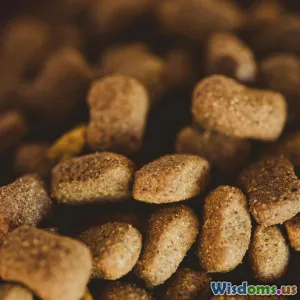
Is Raw Food Best for Your Dog Examining the Raw Diet Craze
8 min read Explore the pros and cons of raw diets for dogs to determine if raw food is truly best for your furry friend’s health and wellbeing. (0 Reviews)
Is Raw Food Best for Your Dog? Examining the Raw Diet Craze
Feeding our dogs is more than just sustenance — it's an investment in their health, longevity, and happiness. In recent years, raw food diets for dogs have soared in popularity, touted by advocates as a return to natural, ancestral eating and a solution to allergies, digestive issues, and dull coats. But is raw food truly the best choice for your dog, or is it a well-intentioned trend with hidden pitfalls?
This article will dive deep into the raw diet craze to provide balanced insights supported by scientific research, expert opinion, real-world examples, and practical guidance.
Understanding the Raw Food Diet for Dogs
The raw food diet typically consists of uncooked meats, bones, organs, fruits, and vegetables, often referred to as BARF (Biologically Appropriate Raw Food or Bones And Raw Food). Proponents argue that this diet mimics what dogs’ ancestors ate before domestication, promoting optimal health.
What Does a Typical Raw Diet Include?
- Muscle Meat: Generally raw skeletal muscle, including sometimes whole prey animals.
- Raw Bones: Seen as crucial for dental health and natural calcium intake.
- Organs: Nutrient-dense parts like liver, kidney, and heart.
- Vegetables and Fruits: Some formulations incorporate plant matter to add fiber and micronutrients.
Veterinarians emphasize that not all raw diets are equal; commercial options vary greatly in nutritional completeness, and homemade diets require careful balancing to avoid deficiencies.
Potential Benefits of a Raw Diet
1. Improved Coat and Skin Health
Many owners report shinier coats and healthier skin in dogs switched to raw. Animal nutritionists suggest that the abundance of omega fatty acids and natural fats supports these improvements.
A study published in The Journal of Small Animal Practice (2018) found dogs on raw diets had better coat quality based on owner surveys and clinical assessments.
2. Enhanced Digestive Function
Advocates claim raw diets produce firmer stools and reduce gas, attributing this to the absence of fillers and processing by-products.
Real-world anecdotal evidence aligns here, though large-scale clinical trials are limited. The raw diet’s natural enzymes could play a role, but this is a pending area of scientific inquiry.
3. Dental Health Advantages
Chewing on raw bones can minimize plaque buildup and maintain dental hygiene. Research published in Veterinary Dentistry (2017) showed reduced tartar in dogs frequently consuming raw meaty bones versus those on kibble diets.
Risks and Concerns Associated with Raw Feeding
1. Bacterial Contamination and Pathogens
Raw meats can carry pathogens like Salmonella, Listeria, or E. coli, posing health risks to both dogs and humans in the household.
The CDC has issued warnings about pet food-associated outbreaks. Vulnerable dogs—such as puppies, elderly, or immunocompromised animals—are at a higher risk of infection.
2. Nutritional Imbalance
Improperly formulated raw diets can lead to calcium/phosphorus imbalances, vitamin deficiencies, or excesses causing skeletal problems, especially in growing puppies.
Consulting with a veterinary nutritionist for tailored supplement plans is essential to avoiding these issues.
3. Bone Hazards
Raw bones are praised for dental health, but they can sometimes splinter, leading to choking, dental fractures, or gastrointestinal obstructions. Careful selection and supervision are vital.
4. Cost and Convenience
Raw diets often require more time for preparation, storage, and handling—and can be more expensive than commercial dry food. This can challenge pet owners’ routines and budgets.
Perspectives from Veterinary Experts
Dr. Lisa Freeman, a board-certified veterinary nutritionist, notes: "While some dogs thrive on raw diets, many do well on balanced commercial foods. It's important that any diet meets established nutritional standards to ensure health and longevity."
The American Veterinary Medical Association (AVMA) currently expresses caution, emphasizing the potential risks of raw feeding and recommending strict hygiene practices if owners choose this route.
Dr. Karen Becker, a holistic vet and raw feeding proponent, counters that when executed properly, raw diets can eliminate many health problems caused by processed foods, stating: "Dogs evolved to thrive on raw meat, and many owners report dramatic improvements."
Real-World Cases and Owner Experiences
Success Stories
Jessica, a dog owner from Atlanta, switched her Labrador to raw after her pet developed chronic ear infections and allergies. Three months later, vet check-ups showed marked improvement in skin condition and energy levels.
Cautionary Tales
Another owner, Mark in Seattle, recounted his puppy ingesting a bone splinter that led to an emergency surgery for intestinal blockage, illustrating the hazards involved.
These stories demonstrate raw diets' potential benefits and risks, underscoring the importance of informed decisions.
Practical Tips for Owners Considering a Raw Diet
- Consult Your Veterinarian or a Nutritionist: Workplace expertise can guide safe transitions and formulation.
- Choose Reputable Commercial Raw Diets: Quality control minimizes contamination risk.
- Practice Safe Food Handling: Clean surfaces, wash hands, and refrigerate food properly.
- Monitor Your Dog Closely: Watch for adverse reactions during diet changes.
- Incorporate Variety: Rotate protein sources and supplements to balance nutrients.
- Avoid Cooked Bones: They become brittle and dangerous.
Conclusion
The raw food diet for dogs presents compelling advantages, such as improved coat health, digestive function, and natural diets aligned with evolutionary history. However, these come with notable risks around bacterial contamination, nutritional imbalances, and physical hazards.
Ultimately, the best diet depends on your dog's individual health needs, lifestyle, and your ability to manage raw food safely. If you choose a raw approach, partnering with veterinary professionals and committing to rigorous safety measures is critical.
In a fast-evolving landscape of pet nutrition, staying informed and attentive remains the surest path to ensuring your dog lives a healthy, vibrant life—whether raw or otherwise.
References:
- Freeman, L.M. et al. "Raw food diets in companion animals: A review." Journal of Small Animal Practice, 2018.
- American Veterinary Medical Association (AVMA). "Raw or undercooked animal-source protein in pet food." 2021.
- Veterinary Dentistry Study, 2017.
- Centers for Disease Control and Prevention (CDC), Pet Food-associated Outbreaks.
Note: This article is for informational purposes only and is not a substitute for professional veterinary advice.
Rate the Post
User Reviews
Popular Posts





















